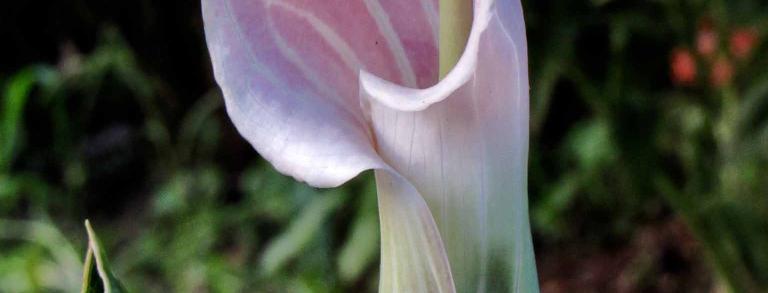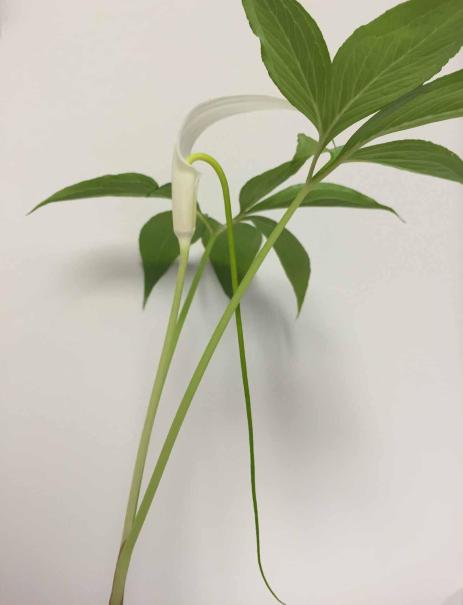A IS FOR aroid... and Alocasia, Amorphophallus, Arisaema, and Arum. The last genus is the most fitting in regard to the rock garden, of course, but let me start where it began for me: May 2002. I quit my full-time, safe job in the legal department of a now very large real estate concern in southeastern Pennsylvania. I took a job pulling weeds and planting annuals with a woman who had a garden maintenance company. It was in a garden we maintained that I was struck. Anyone who knows me well knows this story. I walked over to a shade bed, and there was the most peculiar flower: Arisaema triphyllum, our native jack- in-the-pulpit. You can find them in colonies of hundreds, if you know where to look, in any damp wooded area up and down the East Coast. I still see it, that jack. It was tall, at least 18 inches (45 cm), planted perfectly and shone in the shade; all green and white, no carmine. Nearly everything else just faded for me. You know what I mean. Sure you do. Your kryptonite may be a rare hepatica selection from Japan, or a rheum from Tibet, or something they grow perfectly at the Denver Botanical Gardens but just says “nope” in your garden. But I fell for something local, native, and, heaven forbid, common.
I still have one of the tubers that I collected that year in the woods near where I used to live. I call it my “snarky jack” because it flowers with attitude. I’ll get back to that selection in a bit. With time I began to eschew my first love for the sexy foreigners. The progression went: Japan, Himalayas, China (ohhhh, China), and India. I purchase what I could on my meager salary, and it was never enough. If only I had maxed out my credit cards and bought everything I could have from Heronswood, Asiatica and Seneca Hill. They all closed within two years of one another. Happily, all three of the principals of these concerns have moved on and are still forces to be reckoned with in the horticultural world.
The arisaema failures were (and continue to be) legion for me. To this day I cannot grow a A. griffithii to save my life. I purchase beautiful tubers and the next year they expire. The humidity here in my summers is tough on some higher-altitude dwellers. But the species I’m successful with are still stunners. From the smallest A. triphyllum seedling to the largest A. tortuosum, they are fun in the garden and grow happily in pots.
The American native A. triphyllum does fine in boggy soils that stay moist through winter. Just about every other species will appreciate being dry all winter, usually under limbed-up evergreens or growing among rhododendrons or daphnes. Sitting in damp soil through the winter is a sure way to lose your non-native arisaema tubers. (There are a few exceptions; Arisaema ringens is one that doesn’t mind a little moisture.)
A few years ago, a friend in Australia sent me a picture of another strange aroid: Dracunculus vulgaris. He grows them to perfection and incredible size. A year or two before that, I was given an Amorphophallus konjac tuber, not yet blooming size. These were the slippery slope in my love affair with all things aroid, not just arisaema. The amorphophallus tuber grew to 3 pounds (1.3 kg) and flowered for the first time, in the house, on my birthday a few years ago. My birthday is in mid-March. My poor husband. The flower is terrible to smell for one day and attracts flies which pollinate it. Most of the aroids I grow have foul- smelling flowers.
Most gravel gardeners are growing plants in sun. Arisaemas are not generally thought of as sun plants, but many species love growing in a half day or more of sun. Arisaema candidissimum performs best for me with morning and early afternoon sun. I grow A. consanguineum cultivars in full sun, and they thrive. I wouldn’t recommend putting them against a wall with a western exposure, but in a good rich soil, they are happy with full sun exposure. A. fargesii performs well for me with a couple hours of direct early afternoon sunlight, and the tubers and leaves grow to very large proportions.
But back to my lowly 3phy (my slang name for Arisaema triphyllum). My selection was quite fortuitous. I collected some tubers in the
woods in 2003, and 15 years later I have a plant that has a super wavy inflorescence and is very tall at 3 feet (0.91 m). The most interesting thing about this mature plant is that it is reliably producing three petioles. I’ve never seen that in cultivation or the woods. Fortunately, the tuber is stoloniferous, and I’m patiently waiting to see if the offsets will exhibit the same characteristic. The dark petiole is not too uncommon, but very lovely as well.
Cultivation of arisaemas is simple if you follow some rules. Most easily obtained species are hardy to USDA Zones 6-7. They will happily grow for a couple (or several) years in your garden under the right growing conditions, likely increasing. Then, suddenly, you’ll notice they didn’t come back one year. None of them. What happened? It may have been a nasty winter. They may have succumbed to fusarium (the bane of aroid tubers). Any number of things could happen, but unless you have wild turkeys, it’s likely nothing has dug and eaten them because they are toxic due to oxalic acid in the tubers. You should use gloves when handling tubers as they can cause mild skin irritation. And do not rub your eye after handling tubers. Trust me.
My Arisaema fargesii pictured here is very large. You won’t often see tubers this size. There’s a reason for this; when the tubers get very large they are also very susceptible to rotting over the winter. This species is an amazing offsetter so you mightn’t notice that there was a problem out in the open garden as you would have juveniles coming up. But the way to get heft and continue to grow this size tuber is to lift it each winter. I make sure there is no insect damage, collect the offsets, and then I brag about the size of the tuber to my friends. (It’s the little things. I kill hardy cyclamen every year. I need to have something to natter on about.)
The species of aroids I would suggest for those interested in growing a few would be the following, suitable for growing in Zones 6-9:
Arisaema fargesii - Fantastic when mature with a huge trifoliate leaf.
Arisaema candidissium - Highly desirable and spreads quickly by offsets. You can have a dozen in a couple years, no problem.
Zantedeschia aethiopica - A hardy calla lily that is super pretty mixed among your borders. The large leaves have a hosta-like feel, and the familiar white flowers are lovely and last a couple of weeks at least.
I would recommend Zantedeschia aethiopica ‘Green Goddess’ but she should be lifted to assure her survival as she is not as hardy as the straight species, which should be planted in a protected spot as to not receive the harshest of winter.
Amorphophallus konjac - Hardy to at least Zone 6 and perhaps colder if planted very deep.
Sauromatum giganteum - Super hardy and very odoriferous in flower. This plant is not for the faint-hearted. The stench this little beauty produces can easily be smelled for a day or two from fifty paces. But the inflorescence is gorgeous and looks like velvet. Upon maturity, the leaf will not get very tall, but it will be long, nearly 2 feet (60 cm).
It began for me with a little native and has moved me to explore
so many avenues. My friend in Australia introduced me to other small aroids and encouraged (and enabled) my journey with those that I will not garden without. The branches eventually led me to the rock garden: arums, biarums, and myriad other lovelies that thrill each year. Find your own path, but do make room for the aroid family.


